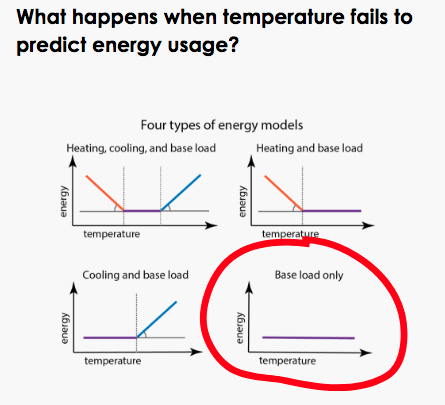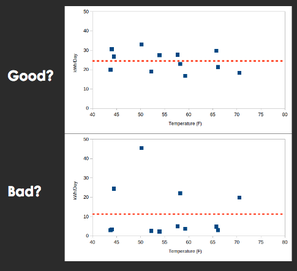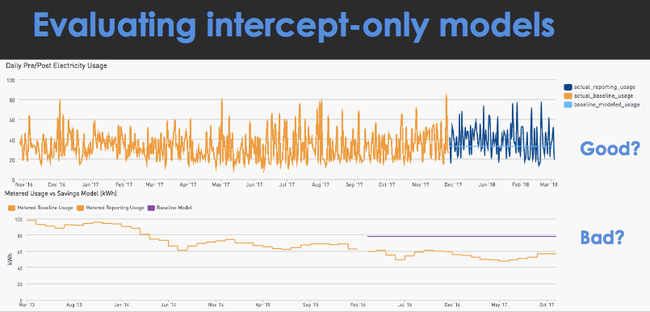|
Week Six CalTRACK Update Week six was primarily focused on the building qualification discussions and will continue to be the focus of testing and experimentation this week; this was coming off of an exciting working group meeting on March 15, 2018 linked below.  Review of properties of intercept-only models in PRISM: As we analyze building qualifications, it is useful to review the properties of PRISM intercept-only models to ensure they are properly treated. Here are a few characteristics of intercept-only models: Properties:
Description of Each Proposed Metric: During the upcoming week, we will use empirical testing to establish the preferred metric and threshold to determine a building’s suitability for CalTrack methods. The two proposed metrics are described below:  Coefficient of Variation Root-Mean-Square-Error (CVRMSE) The CVRMSE is calculated by:
Mean Absolute Percent Error (MAPE) The MAPE is calculated by:
Other Reference Materials on Baseline Models that inform the discussion: In the Granderson, et. al. study cited below, one key question it tackled was: “How can buildings be pre-screened to identify those that are highly model predictable and those that are not, in order to identify estimates of building energy savings that have small errors/uncertainty?”
Suggestions on Testing These Metrics Remember, our goal for testing is to establish our preferred metric and threshold for building qualification. When testing the CVRMSE and MAPE metrics, we have some suggestions to yield the most informative results:
Non-Routine Adjustments: Some discussion arose regarding the possibility of making non-routine adjustments for sites that are outliers. CalTRACK 1.0 addressed this issue by stipulating specific criteria for accepting a non-routine adjustment. Specifically, if savings exceeded 50% +/-, either party would be able to make an appeal to remove the project from the portfolio. Other specific considerations may be related to program eligibility, such as a house that adds solar panels during a performance period. At a general level, CalTRACK methods shy away from stipulating methods for non-routine adjustments, as these tend to demand substantial additional effort and may require additional data that would run contrary to the premise of using CalTRACK methods in the first place. As CalTRACK 1.0 testing demonstrated, for aggregators of residential projects, larger sample sizes diminish the effect of these outliers. Participant Homework:
1 Comment
|
The purpose of this blog is to provide a high-level overview of CalTrack progress.
For a deeper understanding or to provide input on technical aspects of CalTrack, refer to the GitHub issues page (https://github.com/CalTRACK-2/caltrack/issues). Recordings
2019 CalTRACK Kick Off:
CalTRACK 2.0 July 19, 2018 June 28, 2018 June 7, 2018 May 24, 2018 May 3, 2018 April 12, 2018 March 29, 2018 March 15, 2018 March 1, 2018 February 15, 2018 February 1, 2018 Archives
March 2024
|


 RSS Feed
RSS Feed
